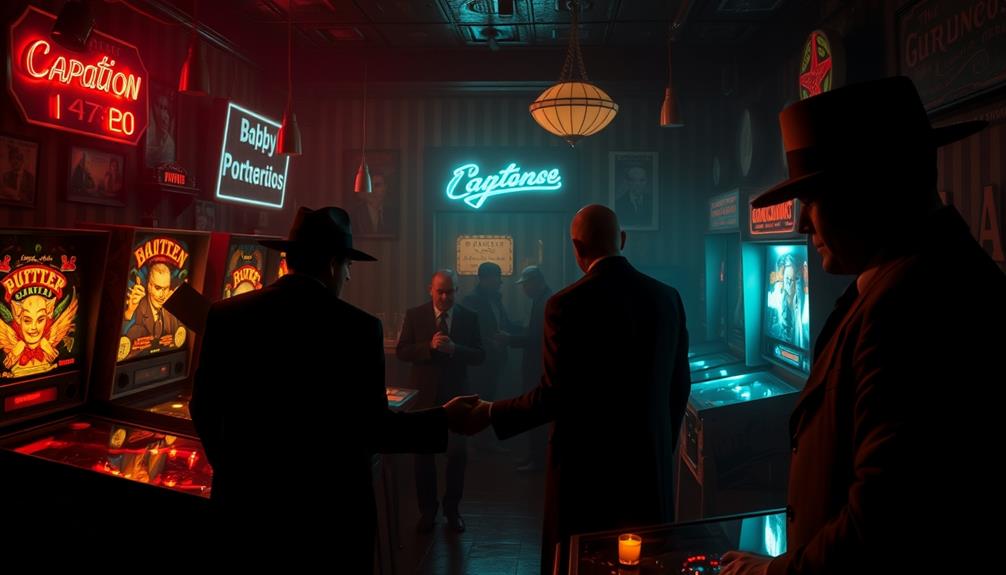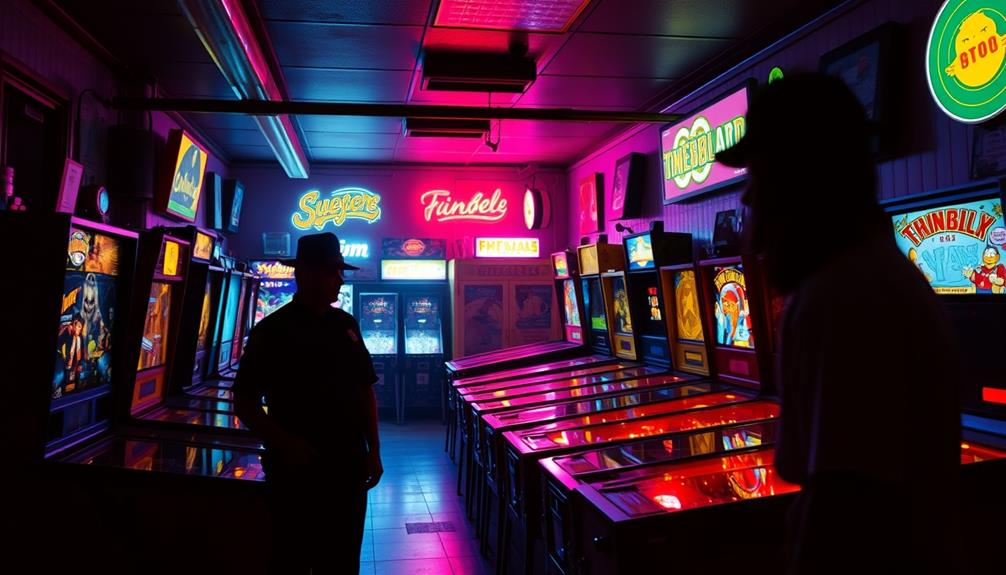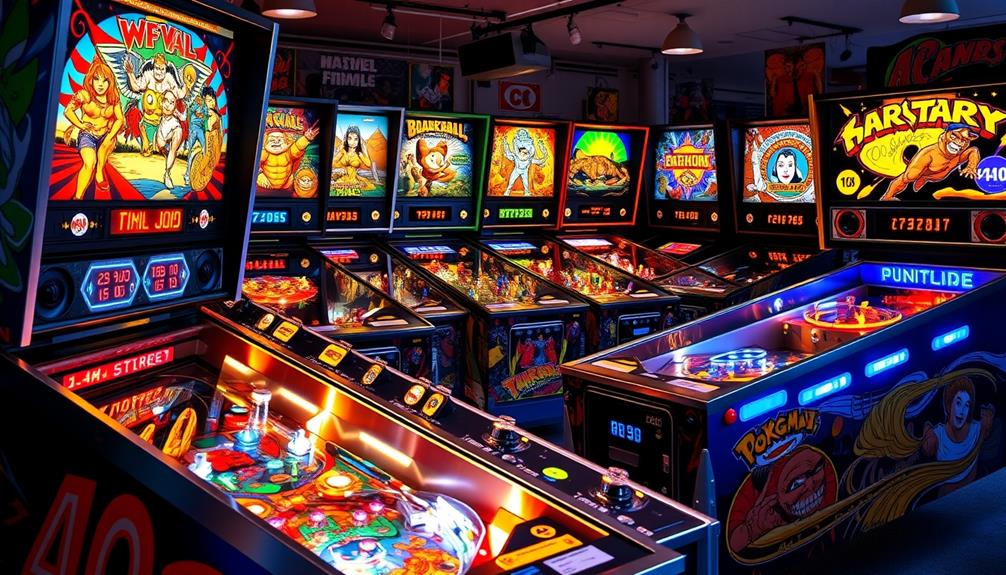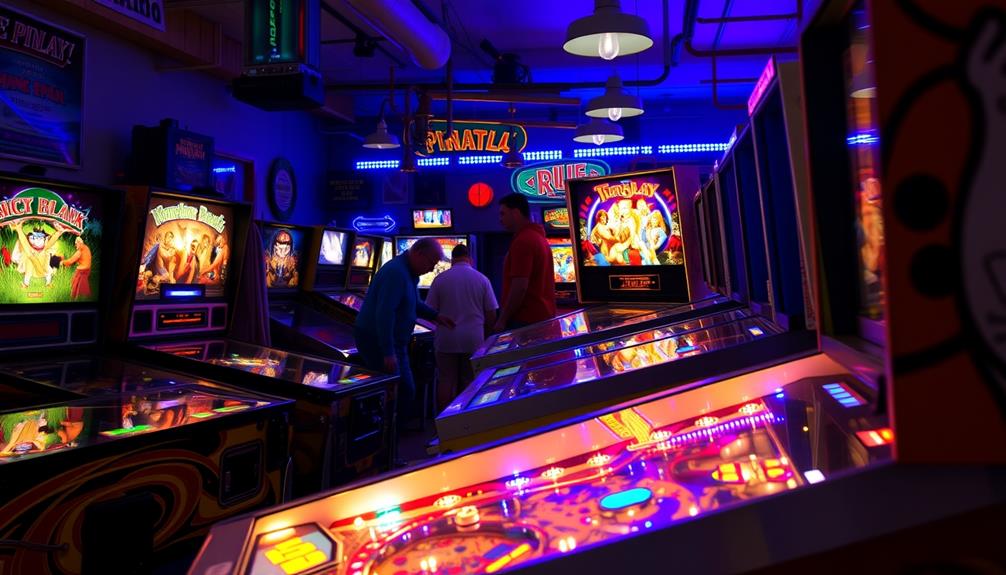Pinball was banned primarily because it was viewed as a gambling device that could corrupt young people. In the 1940s, cities like New York and Chicago linked pinball to organized crime and moral decay. Mayor LaGuardia initiated a crackdown in 1942, destroying thousands of machines to address these concerns. The media amplified worries of juvenile delinquency associated with pinball, further stigmatizing the game. It wasn’t until the 1970s that perceptions started to change, with legal decisions recognizing pinball as a game of skill. Interested in how pinball transformed into a popular pastime? There’s more to the story.
Key Takeaways
- Pinball was illegal due to its associations with gambling, leading to widespread bans in major cities during the 1930s and 1940s.
- Mayor Fiorello La Guardia targeted pinball as a mob-controlled racket, viewing it as a threat to public morality and youth.
- The perception of pinball as a corrupting influence on youth fueled civic leaders' justification for legal restrictions and crackdowns.
- Organized crime exploited pinball machines for illegal gambling, further solidifying societal fears and stigma surrounding the game.
- Legal milestones in the 1970s, particularly the California Supreme Court ruling, began to shift perceptions and lifted the bans on pinball.
Historical Background of Pinball
Pinball machines have a rich history that dates back to the early 19th century, evolving from a simple parlor game inspired by bagatelle. They gained immense popularity in the 1930s, especially during the Great Depression, as a form of affordable entertainment.
However, pinball's rise faced significant challenges. By the 1940s, concerns about its association with gambling led to widespread bans in major cities like New York City and Chicago. The game was often viewed through a lens of financial risk, similar to how poor financial mistakes to avoid can impact individuals today.
Mayor Fiorello La Guardia spearheaded a crusade against pinball in 1942, labeling it a mob-controlled gambling racket. His campaign resulted in the confiscation of thousands of machines, reflecting the public perception of pinball as a corrupting influence on youth. This perception, fueled by its ties to organized crime, catalyzed a sustained crackdown throughout the 1940s and 1950s.
Despite these challenges, pinball began to shift in the 1970s. Legal challenges emerged, culminating in the California Supreme Court's 1974 ruling that classified pinball as a game of skill. This pivotal decision started to change public perception and laid the groundwork for the gradual repeal of bans across various states, marking a significant turning point in pinball's history.
Legal Bans Across the U.S

You might be surprised to learn that pinball faced widespread legal bans across the U.S. due to its gambling associations and the stigma surrounding it.
This stigma was often fueled by societal perceptions of games linked to chance, which can also be seen in discussions about trust issues with boyfriends that stem from inconsistent behaviors.
Government crackdowns, especially in cities like New York, targeted these machines as threats to public morality.
However, legal milestones in the 1970s helped shift perceptions, paving the way for pinball's acceptance as a legitimate form of entertainment.
Gambling Associations and Stigma
Throughout the 1940s, many cities across the U.S. viewed pinball machines as gambling devices, leading to widespread legal bans. Mayor Fiorello LaGuardia of New York City famously enacted a ban in 1942, citing moral concerns tied to illegal gambling, organized crime, and juvenile delinquency.
Public sentiment against pinball was fueled by media sensationalism, which painted these machines as corrupting influences on children and vulnerable citizens. Curiously, the cultural landscape during this period also saw the emergence of various entertainment forms, with a notable focus on dazzling public appearances that further shaped societal views on leisure activities.
The stigma surrounding pinball machines persisted for decades, as many believed they were simply games of chance rather than skill. This perception kept pinball illegal in numerous areas, and the connection to gambling only deepened the divide.
However, a landmark ruling by the California Supreme Court in 1974 began to shift this narrative. The court classified pinball as a game of skill, which laid the groundwork for legalization efforts in various states and cities.
Government Crackdowns on Machines
As the stigma surrounding pinball machines grew, government crackdowns intensified across the U.S. In 1942, the New York City Council enacted a ban on pinball, driven by Mayor Fiorello La Guardia's belief that these machines were a gambling racket controlled by organized crime.
Over 2,000 machines were confiscated, with public displays of destruction to signal the government's commitment to eliminating the game. The perception of pinball as a threat to public morals echoed sentiments found in other areas, such as the concern for health and wellness, where essential oils for toothache relief reflect a desire for natural remedies amidst societal fears.
Other cities, like Chicago, Los Angeles, and Milwaukee, quickly followed suit, sharing concerns about pinball's links to juvenile delinquency and gambling. This widespread crackdown reflected societal fears and the perception that pinball was more than just a game.
Key points to contemplate include:
- The ban on pinball affected the pinball industry considerably.
- LaGuardia's actions were a direct response to organized crime influence.
- Public sentiment viewed pinball machines as gambling devices.
- Roger Sharpe's demonstration in 1976 showcased pinball as a game of skill.
- The eventual lifting of the ban marked a cultural shift in attitudes toward pinball.
These crackdowns shaped the narrative around pinball until legal milestones began to change perceptions in the 1970s.
Legal Milestones and Changes
Numerous legal milestones paved the way for pinball's acceptance as a legitimate form of entertainment in the U.S. Throughout the 1930s and 1940s, pinball was banned in several cities, often tied to concerns about gambling and the exploitation of vulnerable populations, especially children.
This reliance on regulation mirrors the challenges faced by industries dependent on compliance, as seen in the global operations impacted by major outages. In 1942, New York City Mayor Fiorello La Guardia led a campaign against pinball, resulting in the confiscation and destruction of over 2,000 machines.
However, a significant shift occurred in June 1974 when the California Supreme Court legalized pinball in Los Angeles, challenging the prevailing perception of the game.
In 1976, the ban in New York City was overturned after Roger Sharpe demonstrated the skill involved in playing pinball, helping to change public opinion and legal standards.
Public Perception and Moral Concerns

When you think about pinball's history, it's hard to ignore its connection to gambling and the stigma that followed. Many believed these machines drew in young people, leading to delinquency and financial exploitation. This public perception fueled fears and ultimately shaped the legal landscape around pinball for decades.
Additionally, the rise of humor in divorce suggests that societal views on gaming can be just as complex and nuanced, often reflecting deeper cultural anxieties. Such sentiments further complicated the narrative surrounding pinball's place in society.
Gambling Associations and Stigma
Pinball machines once faced significant stigma due to their perceived ties to gambling and moral decay. In the 1940s, cities like New York and Chicago enacted bans, viewing pinball as a threat that exploited vulnerable populations, especially children. This fear wasn't unlike the challenges faced by individuals with Borderline Personality Disorder (BPD), where public misconceptions can lead to societal stigma and misunderstanding.
Mayor Fiorello LaGuardia famously branded it a mob-controlled gambling racket, leading to the confiscation of over 2,000 machines in 1942. The sensationalized media narratives further fueled public sentiment, painting pinball as a corrupting influence linked to juvenile delinquency.
Here are some key reasons for the stigma surrounding pinball:
- Coin-operated nature often equated to gambling.
- Public fears of organized crime connections.
- Legal bans reinforced perceptions of illegality.
- Misunderstanding of pinball as purely a game of chance.
- Media portrayal as a moral threat to communities.
Despite evolving into a skill-based game with the introduction of flippers, the stigma persisted for decades. The shift began in the 1970s when legal challenges, like a California Supreme Court ruling in 1974, began to redefine pinball's identity.
Ultimately, overcoming the legacy of gambling associations took time and effort, but the game's cultural significance remains undeniable.
Youth Delinquency Concerns
Concerns over youth delinquency played a significant role in shaping public perception of pinball during its prohibition. In the 1940s, pinball machines were often labeled as corrupting influences, believed to encourage gambling habits among youth. Civic leaders and media sensationalized this connection, framing pinball as a serious threat to the morals and finances of schoolchildren.
Some argued that the allure of pinball machines mirrored the astrological charm that captivated young people, further raising alarms about their influence. Mayor Fiorello LaGuardia led the charge against pinball, portraying these machines as instruments of organized crime that exploited vulnerable citizens. His anti-pinball campaign highlighted fears of moral decay, as public outcry grew against what many saw as a dangerous pastime.
The staged destruction of pinball machines during raids was a dramatic way to demonstrate the government's commitment to combating these perceived threats. Legal bans in cities like New York and Chicago were justified by claims that pinball contributed to delinquency.
As pinball became synonymous with gambling and juvenile mischief, the legal restrictions only intensified. Ultimately, the fear of youth being led astray by pinball machines fueled a movement that transformed public perception, leading to a significant crackdown on the once-beloved game.
The Role of Organized Crime

During the 1940s, pinball machines became notorious for their connections to organized crime, serving as fronts for illegal gambling and money laundering operations. Mobsters exploited these machines to control gambling operations, often targeting vulnerable populations who were easily lured into betting. This led to increased attention from law enforcement, as testimonies, like that from the Kings County District Attorney, revealed the deep ties between pinball and gang activities.
Additionally, the financial implications of these operations mirrored other challenges faced by vulnerable groups, such as the need for financial safety from scams. Cities like Chicago took drastic measures, enacting strict anti-pinball regulations to curb the influence of organized crime. The societal fears surrounding these machines only fueled the stigma, reinforcing the belief that pinball was inherently linked to illegal activities.
Here are some key points to reflect on:
- Pinball machines were often found in bars, making them accessible for gambling.
- Mobsters used profits from pinball to fund other illegal ventures.
- Law enforcement faced challenges in regulating these operations effectively.
- The connection to organized crime led to widespread prohibition in various cities.
- The fear of exploitation of vulnerable populations played a significant role in the backlash against pinball.
These factors made pinball a target for legislation aimed at combating organized crime.
Shifts in Legality During the 1970s

A remarkable transformation in the perception of pinball occurred in the 1970s as legal challenges began to reshape its status across the United States. In 1974, the California Supreme Court ruled that pinball was a game of skill rather than chance, considerably altering its legal status. This ruling prompted cities to reconsider their bans on pinball, particularly in New York City, which lifted its prohibition in 1976 after a demonstration by Roger Sharpe showcased the skill involved in gameplay.
| Year | City | Action Taken |
|---|---|---|
| 1974 | California | Ruling: Pinball = Skill |
| 1976 | New York City | Ban lifted, $1.5M revenue |
| 1977 | Chicago | Pinball legalized |
The successful challenge in NYC highlighted the potential for considerable licensing revenue, encouraging other cities to relax their restrictions. By 1977, Chicago followed suit, marking a broader trend toward acceptance of pinball as a legitimate entertainment form rather than a gambling vice. Throughout the late 1970s, many cities across the U.S. lifted their pinball bans, reflecting a cultural shift in viewing the game as a recreational activity instead of a threat to public morality.
Pinball's Cultural Resurgence

Revival defines pinball's journey in recent decades, as it transforms from a once-maligned pastime into a celebrated cultural phenomenon. The turning point came in the 1970s when cities like New York City lifted bans, reshaping pinball from a gambling vice into a legitimate form of entertainment.
The California Supreme Court's 1974 ruling deemed pinball a game of skill, sparking legalization efforts across the nation. This resurgence parallels other cultural movements, including the celebration of Southern traditions seen in events like Paula Deen's wedding, emphasizing the importance of community and shared experiences.
Today, pinball boasts a vibrant community that thrives on:
- Competitive leagues and tournaments, with over 1,800 held annually.
- Modern machines featuring intricate designs and pop culture themes.
- Barcades that blend food, drinks, and classic pinball for a unique social experience.
- A resurgence in interest among younger generations enthusiastic to explore this nostalgic game.
- Events that celebrate pinball culture, fostering camaraderie and competition.
With its rich history and evolving appeal, pinball continues to captivate players, proving that it's more than just a game—it's a cultural resurgence that highlights skill and community engagement, making it an enduring icon in the entertainment landscape.
Frequently Asked Questions
Where Is Pinball Still Illegal?
You walk down vibrant streets, spotting pinball machines behind glass, yet in Oak Park, Illinois, and parts of California, they're still banned. Nashville's restrictions just lifted, reminding you of pinball's quirky legal journey.
Why Was Pinball Illegal in California?
You might find it surprising that pinball was once illegal in California. People viewed it as a game of chance, linking it to gambling and crime, which prompted strict laws against its operation and ownership. However, in 1976, a landmark case in California overturned these laws, establishing pinball as a game of skill rather than chance. Since then, the history of pinball machines has seen a resurgence in popularity, with dedicated fans and collectors embracing the unique design and mechanics of these vintage games. Today, pinball machines are not only legal but also celebrated as a form of entertainment and art.
Was Pinball Illegal in the 1970S?
In the 1970s, pinball danced on the edge of legality. You'd find it banned in some places, yet cities like New York began to embrace its charm, transforming perceptions and sparking a vibrant revival.
Why Were Pinball Machines Illegal in New York City?
In New York City, pinball machines faced a ban due to concerns about gambling and organized crime. Authorities believed they exploited vulnerable people, leading to a crackdown fueled by public sentiment and moral outrage.
Conclusion
Pinball's journey from illegal to beloved reflects society's shifting values. Once seen as a symbol of vice and crime, it's now celebrated for its artistry and nostalgia. You can sense the thrill of the game, where chance meets skill, contrasting with the moral panic that once surrounded it. As you flip the flippers, remember that what was once outlawed now lights up arcades, bridging the gap between rebellion and recreation, proving that fun can indeed triumph over fear.









